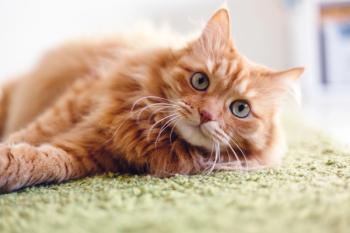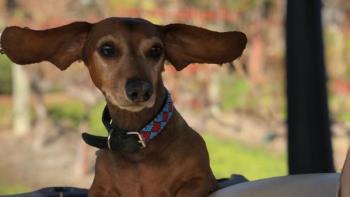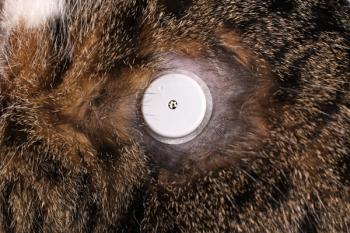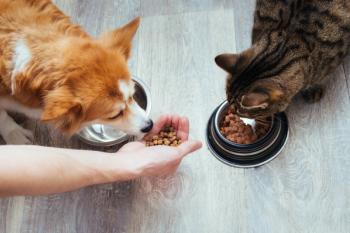
Feline hyperthyroidism: Management and options for treatment
Hyperthyroidism is recognized as the most common endocrinopathy of older cats. Despite worldwide occurrence, the pathogenesis of feline hyperthyroidism remains unclear.
Hyperthyroidism is recognized as the most common endocrinopathy of older cats. Despite worldwide occurrence, the pathogenesis of feline hyperthyroidism remains unclear. Traditional methods of managing feline hyperthyroidism include thyroidectomy, anti-thyroid medications, and radioactive iodine. Recent studies document that another option now exists for hyperthyroid cats; feeding a limited-iodine food normalizes thyroid hormone concentrations and alleviates clinical signs of hyperthyroidism. Surgery and radioactive iodine are designed to provide permanent solutions, whereas, oral anti-thyroid drugs and nutritional management control hyperthyroidism and are needed daily to achieve/maintain their effect. All management options are effective and each has its pros and cons. It's important to discuss all options with pet owners so the appropriate management can be selected for each hyperthyroid cat.
Diagnosis
Diagnosis most often is based on the presence of one or more typical clinical signs and increased serum total thyroxine (T4) concentration. However, up to 10% of all hyperthyroid cats and 40% of those with mild disease have serum T4 values within reference range 1,2 The diagnosis of hyperthyroidism should not be excluded on the basis of a single normal serum T4 value, especially in a cat with typical clinical signs, a palpable thyroid nodule and serum T4 in the upper half of the normal range.
Management options
Once hyperthyroidism has been diagnosed, all management options (thyroidectomy, radioactive iodine, anti-thyroid drugs, nutritional management) should be discussed with pet owners. All options can be ≥ 90% effective for controlling hyperthyroidism when used appropriately. The selected management option will differ for each cat based on several considerations (Table 1). Radioactive iodine therapy is considered the gold standard for treatment of hyperthyroidism; however, most pet owners currently opt for medical management. Until recently, this included oral or transdermal anti-thyroid drugs. Now nutritional management using a limited-iodine food is another option for cats with hyperthyroidism.
Radioactive iodine
Radioiodine treatment is often considered the best option for many hyperthyroid cats because:
- It has the potential to eliminate a benign thyroid tumor or abnormal thyroid tissue with a single treatment
- It treats extra-thyroidal thyroid tissue, which may occur in 10 to 20% of hyperthyroid cats
- No general anesthesia is required
- Reported side effects are minimal
Cats should be stable prior to radioiodine therapy; those with clinically significant cardiovascular, renal, gastrointestinal, or endocrine (e.g., diabetes mellitus) disease may not be very good candidates, especially because of the time necessary for boarding after treatment.5
After administration, radioactive iodine is actively concentrated by the thyroid gland and has a half-life of 8 days. It emits both ß-particles and γ-radiation; the ß-particles are responsible for the majority of tissue destruction, but are only locally destructive, traveling a maximum of 2 mm. Therefore, no significant damage to adjacent parathyroid tissue, atrophic thyroid tissue, or other cervical structures is expected. The main limitation to widespread use of radioactive iodine is the requirement for special licensing and the isolation of the cat for variable periods after treatment. This can range from several days to several weeks depending on state or local radiation regulations and the dose administered.
The goal of treatment is to restore euthyroidism with the smallest possible single dose of radioactive iodine, while avoiding development of hypothyroidism.
Anti-thyroid drugs
Anti-thyroid drugs (e.g., methimazole, carbimazole) are commonly used for treatment of hyperthyroidism in cats. 14-21 If administered appropriately, they reliably inhibit the synthesis of thyroid hormones and thereby lower serum thyroid hormone concentrations. These drugs do not affect the thyroid gland's ability to trap inorganic iodide or release preformed hormones. They are widely recommended to stabilize hyperthyroid cats prior to surgery and are the only drugs that can be used chronically for management of hyperthyroidism.
Anti-thyroid drugs used most often in cats include methimazole and carbimazole; both can be given orally or formulated for transdermal application. Custom formulation of transdermal products may increase expense of therapy and stability of the product is not guaranteed. Results of a recent prospective study conducted in New Zealand showed that once daily treatment for 12 weeks with transdermal methimazole in a novel lipophilic vehicle was as effective as twice-daily carbimazole administered orally.
While many cats have been successfully managed long-term with anti-thyroid drugs, it's important to monitor for potential side effects that have been associated with their use.15,18,19,21 In the study with the largest number of cats, 18% had side effects associated with methimazole; a more recent study revealed that 44% of 39 cats had side effects.15,19 In 44 cats receiving carbimazole for 1 year, 44% had associated side effects with gastrointestinal signs (decreased appetite, vomiting, diarrhea) being most common. In another study, 13% of 39 cats treated with carbimazole experienced side effects.
Most adverse reactions occur within the first few weeks to months after beginning therapy and include depression, inappetence, vomiting, and self-induced excoriations of the head and neck (facial pruritus). Gastrointestinal signs are less common with transdermal administration of methimazole.
Nutritional management
Production of thyroid hormone requires uptake by the thyroid gland of sufficient amounts of iodine, which is provided by dietary intake. The only function for ingested iodine is for thyroid hormone synthesis.5 This observation led to the hypothesis that limiting dietary iodine intake could be used to control thyroid hormone production and potentially manage hyperthyroidism in cats. After more than a decade of research and development, a limited-iodine therapeutic food (Hill's® Prescription Diet® y/dTM Feline) containing < 0.3 ppm (mg/kg) iodine on a dry matter basis (DMB), is now available as an option for managing cats with hyperthyroidism.
Iodine content of commercial cat foods
Iodine occurs naturally in many ingredients typically used in the manufacture of commercial pet foods (particularly fish, shellfish and fresh meats) and unless steps are taken to strictly control the iodine content of ingredients, the final iodine concentration in pet foods varies widely.
Multiple feeding trials have been conducted in a research colony using over 100 cats with naturally occurring hyperthyroidism to determine the safety and effectiveness of limited dietary iodine in the management of the disease. The results of all studies support that a therapeutic food with dietary iodine ≤ 0.3 ppm iodine (dry matter basis) provides a safe and effective management option for cats with naturally occurring hyperthyroidism. Serum total thyroxine concentrations return to the normal range within 4 to 12 weeks of initiating nutritional management and 90% hyperthyroid cats maintained on the limited-iodine food as the sole source of nutrition become euthyroid.
Three studies were designed to determine the magnitude of iodine control necessary to return newly diagnosed cats to a euthyroid state;
We have treated 22 cats to date with feline y/d with follow-up data for at least 6 months. All of the cats found at least one form of the diet (dry or canned) to be palatable. Nineteen of 22 (86%) cats experienced clinical improvement with normalization of their TT4 concentrations. Of the three cats that failed to achieve remission, 2 cats were discovered to be eating foods other than y/d and when the owners switched them to y/d exclusively remission of hyperthyroidism was achieved. One cat (5%) failed to respond to dietary therapy and was subsequently treated with 131-I.
We are currently conducting a prospective study evaluating the efficacy of feline y/d in managing feline hyperthyroidism to include monitoring of thyroid function (TT4, fT4ED, TSH), clinical signs, body weight, renal function and blood pressure pre and post-treatment. The study should be completed in 2015.
Newly diagnosed patients
After confirming the diagnosis and performing a thorough patient evaluation, nutritional management should be discussed along with other options for managing hyperthyroidism. If selected as the management option, gradual transition to the limited-iodine food (Hill's® Prescription Diet® y/dTM Feline) over at least 7 days is recommended. It is very important to counsel owners so they understand that success of nutritional management depends on the limited-iodine food being the sole source of nutrition for their cat.
The first recheck evaluation should be done 4 weeks after completing the transition to y/d Feline (i.e., once the cat has eaten y/d exclusively for 4 weeks) and as a minimum should include physical examination and measurement of T4, BUN, serum creatinine, and urine specific gravity. All cats should have decreased T4 concentrations compared with baseline and many will have returned to normal by the 4-week evaluation. Clinical improvement including weight gain, improved hair coat and decreased tachycardia/cardiac murmur also may be noted by the first evaluation. Clinical signs should continue improving by the next re-evaluation at 8 weeks and most cats will be euthyroid. Some cats require slightly longer to become euthyroid; however, it's expected that 90% will have normal T4 concentrations if the limited-iodine food is their sole source of nutrition.
If euthyroidism is not achieved within 4 to 12 weeks, a thorough history is indicated to confirm that only the limited-iodine food is being fed.
Managing hyperthyroid cats with concurrent kidney disease
Chronic kidney disease (CKD) and hyperthyroidism are more likely to be diagnosed in older cats so it's not surprising that many hyperthyroid cats have CKD. Untreated hyperthyroidism complicates the diagnosis of CKD because it's associated with increased glomerular filtration rate (GFR) and therefore often masks biochemical markers of CKD. Regardless of the therapeutic modality (methimazole, surgical thyroidectomy, or radioiodine), decreased GFR, increased serum urea and creatinine concentrations and development of overt clinical signs of kidney disease have been reported after successful treatment of hyperthyroidism.4,33-36 The presence of underlying CKD may affect the prognosis - one study documented a shorter survival time in hyperthyroid cats with azotemia.
The reported occurrence of azotemia after treatment of hyperthyroidism ranges from 15 to 49%. 31,35-37,40 Iatrogenic hypothyroidism has been reported to decrease GFR in human patients.
It's not possible to consistently predict which cats will develop overt CKD after treatment of hyperthyroidism or have progression of their kidney disease. This should be considered when deciding on treatment options, particularly those that are irreversible (thyroidectomy, radioactive iodine). Regardless of the option selected for managing hyperthyroidism, it's important to remember that the only intervention shown to improve quality of life and prolong survival time in cats with naturally occurring CKD is feeding a therapeutic renal food.42,43 Until recent availability of limited-iodine food, nutritional recommendations have not generally been considered for hyperthyroid cats without azotemia. In cats with compromised renal function, but without azotemia (IRIS Stage 1), the decrease in GFR associated with normalizing serum T4 levels may be sufficient to prevent effective clearing of protein metabolic by-products (BUN and creatinine) when dietary intake of protein and phosphorus is high. This could contribute to the occurrence of post-therapy azotemia in hyperthyroid cats.
In our work with 22 cats with hyperthyroidism treated with feline y/d, 4/22 cats (18%) were azotemic (IRIS Stage 1 and 2 CKD) prior to starting the diet. All 4 cats experienced normalization of their BUN and creatinine within 30-150 days along with normalization of their TT4's. One potential explanation is that the expected decrease in GFR associated with normalizing serum T4 may be offset by the nutrient profile of the limited-iodine food which is similar foods for mature adult cats or cats with early CKD. Additional study is needed to better understand the effects of using limited-iodine food on hyperthyroid cats with concurrent kidney disease.
Conclusions/summary
Hyperthyroidism is the most common endocrine disease of older cats worldwide. While the pathogenesis is unclear, several effective management options are available. All should be discussed with pet owners, including pros/cons, so that the best option can be selected for individual patients and their owners. Feeding a limited-iodine food is now available as an option for effective management of hyperthyroid patients. When fed as the sole source of nutrition, approximately 90% of hyperthyroid cats become euthyroid within 4 to 12 weeks. To date, over 150 cats with naturally occurring hyperthyroidism have been managed successfully by feeding a limited-iodine food, most for 2-3 years and some cats for as long as 6 years.
Newsletter
From exam room tips to practice management insights, get trusted veterinary news delivered straight to your inbox—subscribe to dvm360.




